语言性别差异研究
- 格式:doc
- 大小:97.50 KB
- 文档页数:13
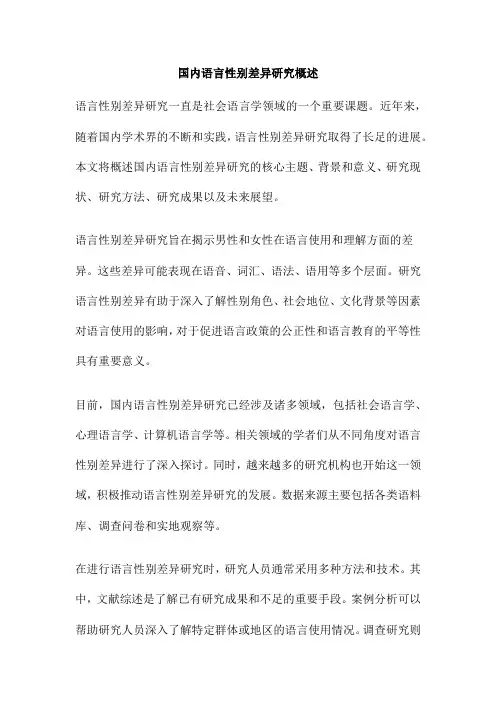
国内语言性别差异研究概述语言性别差异研究一直是社会语言学领域的一个重要课题。
近年来,随着国内学术界的不断和实践,语言性别差异研究取得了长足的进展。
本文将概述国内语言性别差异研究的核心主题、背景和意义、研究现状、研究方法、研究成果以及未来展望。
语言性别差异研究旨在揭示男性和女性在语言使用和理解方面的差异。
这些差异可能表现在语音、词汇、语法、语用等多个层面。
研究语言性别差异有助于深入了解性别角色、社会地位、文化背景等因素对语言使用的影响,对于促进语言政策的公正性和语言教育的平等性具有重要意义。
目前,国内语言性别差异研究已经涉及诸多领域,包括社会语言学、心理语言学、计算机语言学等。
相关领域的学者们从不同角度对语言性别差异进行了深入探讨。
同时,越来越多的研究机构也开始这一领域,积极推动语言性别差异研究的发展。
数据来源主要包括各类语料库、调查问卷和实地观察等。
在进行语言性别差异研究时,研究人员通常采用多种方法和技术。
其中,文献综述是了解已有研究成果和不足的重要手段。
案例分析可以帮助研究人员深入了解特定群体或地区的语言使用情况。
调查研究则是通过收集和分析大规模数据来探讨语言性别差异的表现和影响因素。
国内语言性别差异研究已经取得了一系列成果。
研究发现,男性和女性在语言使用方面存在一些显著差异。
例如,女性更倾向于使用礼貌用语和情感表达,而男性更倾向于使用粗俗语和强调权威。
男性和女性在语言理解方面也存在差异,女性更容易理解情感丰富的语言表达,而男性则更注重语言的逻辑性和简洁性。
然而,这些差异并不绝对,也会受到文化、教育等因素的影响。
尽管国内语言性别差异研究已经取得了一定的成果,但也存在一些不足和争议。
部分研究结果可能受到研究方法和数据来源的限制,需要进一步验证。
语言性别差异研究涉及到诸多复杂因素,如历史文化、社会心理等,需要进一步深入探讨。
随着全球化和网络化的发展,新兴的语言现象和交流方式也为语言性别差异研究带来了新的挑战和机遇。
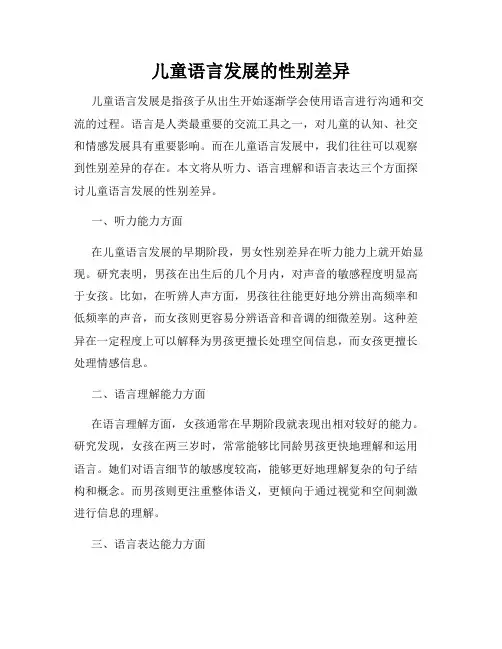
儿童语言发展的性别差异儿童语言发展是指孩子从出生开始逐渐学会使用语言进行沟通和交流的过程。
语言是人类最重要的交流工具之一,对儿童的认知、社交和情感发展具有重要影响。
而在儿童语言发展中,我们往往可以观察到性别差异的存在。
本文将从听力、语言理解和语言表达三个方面探讨儿童语言发展的性别差异。
一、听力能力方面在儿童语言发展的早期阶段,男女性别差异在听力能力上就开始显现。
研究表明,男孩在出生后的几个月内,对声音的敏感程度明显高于女孩。
比如,在听辨人声方面,男孩往往能更好地分辨出高频率和低频率的声音,而女孩则更容易分辨语音和音调的细微差别。
这种差异在一定程度上可以解释为男孩更擅长处理空间信息,而女孩更擅长处理情感信息。
二、语言理解能力方面在语言理解方面,女孩通常在早期阶段就表现出相对较好的能力。
研究发现,女孩在两三岁时,常常能够比同龄男孩更快地理解和运用语言。
她们对语言细节的敏感度较高,能够更好地理解复杂的句子结构和概念。
而男孩则更注重整体语义,更倾向于通过视觉和空间刺激进行信息的理解。
三、语言表达能力方面在语言表达方面,男孩往往在早期阶段相对较慢,但在后期往往会迅速迎头赶上。
根据研究,男孩在两三岁时的词汇和语言产出量可能较女孩少,但到了学龄期,男孩的语言表达能力通常会与女孩相当甚至超过。
这一差异可能与男孩的空间理解和视觉能力的提升有关,他们更喜欢通过动作、图像等非语言方式表达自己的意思。
综上所述,儿童语言发展的性别差异主要表现在听力、语言理解和语言表达能力方面。
男孩往往更擅长处理空间信息,对声音的敏感性较高;女孩则在语言理解和细节把握方面具有优势。
此外,男孩的语言表达能力可能相对滞后但会在后期迎头赶上。
了解这些性别差异对于教育和家庭教育有着一定的启示意义。
然而,需要强调的是,上述性别差异只是一般趋势,并不代表个体之间存在绝对的差异。
每个孩子都具有独特的语言发展过程,性别只是其中的一个因素。
因此,在教育过程中,我们应当注重每个孩子个体的需求和差异,积极提供适宜的语言环境和支持,帮助他们健康、全面地发展语言能力。
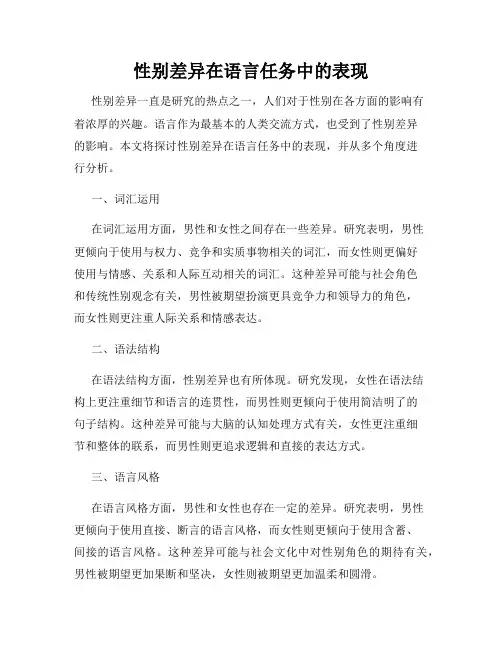
性别差异在语言任务中的表现性别差异一直是研究的热点之一,人们对于性别在各方面的影响有着浓厚的兴趣。
语言作为最基本的人类交流方式,也受到了性别差异的影响。
本文将探讨性别差异在语言任务中的表现,并从多个角度进行分析。
一、词汇运用在词汇运用方面,男性和女性之间存在一些差异。
研究表明,男性更倾向于使用与权力、竞争和实质事物相关的词汇,而女性则更偏好使用与情感、关系和人际互动相关的词汇。
这种差异可能与社会角色和传统性别观念有关,男性被期望扮演更具竞争力和领导力的角色,而女性则更注重人际关系和情感表达。
二、语法结构在语法结构方面,性别差异也有所体现。
研究发现,女性在语法结构上更注重细节和语言的连贯性,而男性则更倾向于使用简洁明了的句子结构。
这种差异可能与大脑的认知处理方式有关,女性更注重细节和整体的联系,而男性则更追求逻辑和直接的表达方式。
三、语言风格在语言风格方面,男性和女性也存在一定的差异。
研究表明,男性更倾向于使用直接、断言的语言风格,而女性则更倾向于使用含蓄、间接的语言风格。
这种差异可能与社会文化中对性别角色的期待有关,男性被期望更加果断和坚决,女性则被期望更加温柔和圆滑。
四、沟通方式性别差异还会在沟通方式上产生明显的表现。
男性更倾向于进行竞争性的对话,注重展示自己的观点和控制对话的节奏,而女性则更注重合作性的对话,重视共识和谦逊的表达方式。
这种差异可能与社会角色和性别社会化有关,男性被期望在沟通中展现自信和权威,女性则被期望更具合作性和社交性。
总结起来,性别差异在语言任务中存在明显的表现。
在词汇运用、语法结构、语言风格和沟通方式等方面,男性和女性有着不同的表现倾向。
这种差异可能与社会文化角色的期待、认知差异和性别社会化等因素密切相关。
深入了解性别差异在语言任务中的表现,对于实现更有效的性别平等和促进性别意识的提升具有积极的意义。
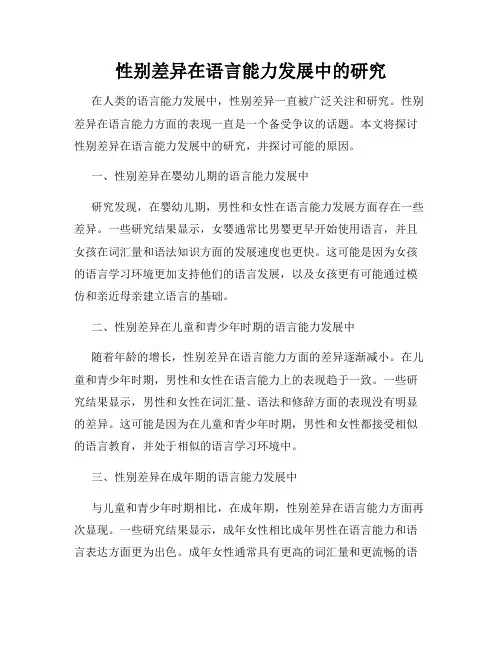
性别差异在语言能力发展中的研究在人类的语言能力发展中,性别差异一直被广泛关注和研究。
性别差异在语言能力方面的表现一直是一个备受争议的话题。
本文将探讨性别差异在语言能力发展中的研究,并探讨可能的原因。
一、性别差异在婴幼儿期的语言能力发展中研究发现,在婴幼儿期,男性和女性在语言能力发展方面存在一些差异。
一些研究结果显示,女婴通常比男婴更早开始使用语言,并且女孩在词汇量和语法知识方面的发展速度也更快。
这可能是因为女孩的语言学习环境更加支持他们的语言发展,以及女孩更有可能通过模仿和亲近母亲建立语言的基础。
二、性别差异在儿童和青少年时期的语言能力发展中随着年龄的增长,性别差异在语言能力方面的差异逐渐减小。
在儿童和青少年时期,男性和女性在语言能力上的表现趋于一致。
一些研究结果显示,男性和女性在词汇量、语法和修辞方面的表现没有明显的差异。
这可能是因为在儿童和青少年时期,男性和女性都接受相似的语言教育,并处于相似的语言学习环境中。
三、性别差异在成年期的语言能力发展中与儿童和青少年时期相比,在成年期,性别差异在语言能力方面再次显现。
一些研究结果显示,成年女性相比成年男性在语言能力和语言表达方面更为出色。
成年女性通常具有更高的词汇量和更流畅的语言表达能力。
这可能是因为女性更加注重细节和语言的使用,同时女性在语言教育和文字表达方面也更加重视。
四、可能的原因性别差异在语言能力发展中的存在可以有多种可能的原因。
首先,社会文化因素可能对性别差异产生影响。
不同的文化对男女在语言能力上的期望和要求可能不同,这可能导致男女在语言能力上的差异。
其次,生物学因素也可能是造成性别差异的原因之一。
男性和女性在大脑结构和功能上存在一些差异,这可能影响到他们在语言能力方面的表现。
总结性别差异在语言能力发展中的研究表明,在不同的发展阶段,男性和女性在语言能力方面可能存在一定的差异。
然而,这种差异并不是绝对的,在儿童和青少年时期逐渐减小,而在成年期再次显现。
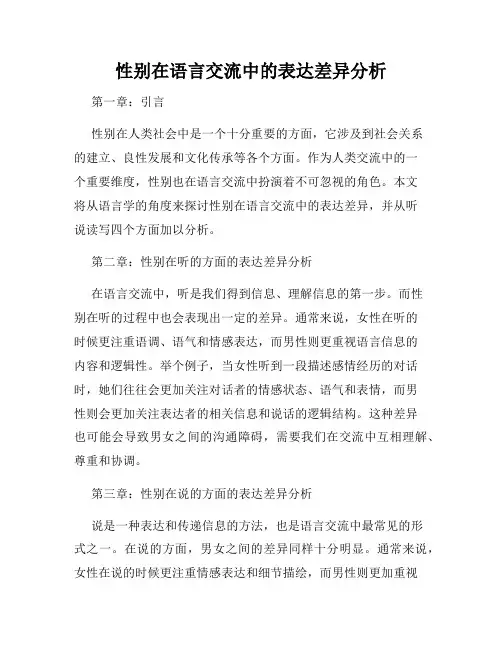
性别在语言交流中的表达差异分析第一章:引言性别在人类社会中是一个十分重要的方面,它涉及到社会关系的建立、良性发展和文化传承等各个方面。
作为人类交流中的一个重要维度,性别也在语言交流中扮演着不可忽视的角色。
本文将从语言学的角度来探讨性别在语言交流中的表达差异,并从听说读写四个方面加以分析。
第二章:性别在听的方面的表达差异分析在语言交流中,听是我们得到信息、理解信息的第一步。
而性别在听的过程中也会表现出一定的差异。
通常来说,女性在听的时候更注重语调、语气和情感表达,而男性则更重视语言信息的内容和逻辑性。
举个例子,当女性听到一段描述感情经历的对话时,她们往往会更加关注对话者的情感状态、语气和表情,而男性则会更加关注表达者的相关信息和说话的逻辑结构。
这种差异也可能会导致男女之间的沟通障碍,需要我们在交流中互相理解、尊重和协调。
第三章:性别在说的方面的表达差异分析说是一种表达和传递信息的方法,也是语言交流中最常见的形式之一。
在说的方面,男女之间的差异同样十分明显。
通常来说,女性在说的时候更注重情感表达和细节描绘,而男性则更加重视事实表述和逻辑推理。
举个例子,当女性描述某件事情时,她们可能会涉及相对复杂的情感和感受,并用形容词和副词来具体描绘相关情景;而男性则更可能用简单明了的词汇来直接表述事件的事实。
这种差异也可能会导致在交流中的误解和冲突,需要我们在交流中保持耐心和毅力,细心倾听和理解对方的表达方式和意图。
第四章:性别在读的方面的表达差异分析在阅读过程中,读者需要理解文本的内容和意义、掌握作者的观点和态度,这也是语言交流中非常重要的一个方面。
在读的方面,男女之间也会表现出一定的差异。
通常来说,女性在读的时候更注重文本的情感表达和想象力的发挥,而男性则更注重文本的逻辑性和信息的获取。
举个例子,当女性读一篇小说时,她们可能会更容易感同身受,沉浸在小说情境中,而男性则可能会更注重文本的结构和情节的推进。
这种差异也可能导致男女之间在阅读中的理解差异,需要我们认识到性别在阅读方面的差异,尊重不同的阅读方式,并在阅读上互相启发和学习。
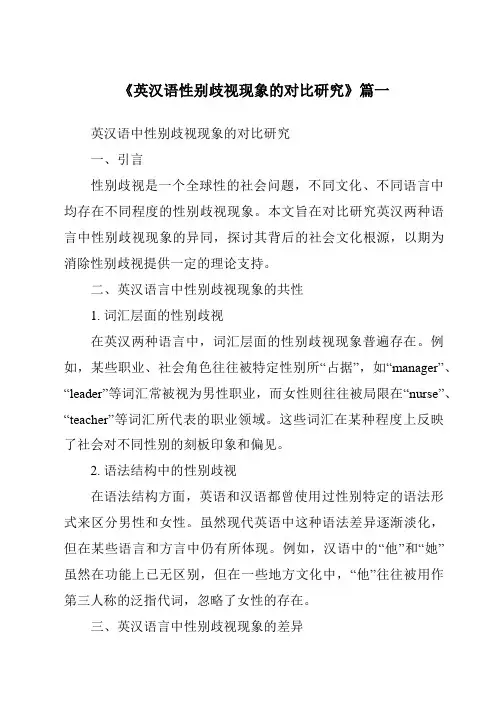
《英汉语性别歧视现象的对比研究》篇一英汉语中性别歧视现象的对比研究一、引言性别歧视是一个全球性的社会问题,不同文化、不同语言中均存在不同程度的性别歧视现象。
本文旨在对比研究英汉两种语言中性别歧视现象的异同,探讨其背后的社会文化根源,以期为消除性别歧视提供一定的理论支持。
二、英汉语言中性别歧视现象的共性1. 词汇层面的性别歧视在英汉两种语言中,词汇层面的性别歧视现象普遍存在。
例如,某些职业、社会角色往往被特定性别所“占据”,如“manager”、“leader”等词汇常被视为男性职业,而女性则往往被局限在“nurse”、“teacher”等词汇所代表的职业领域。
这些词汇在某种程度上反映了社会对不同性别的刻板印象和偏见。
2. 语法结构中的性别歧视在语法结构方面,英语和汉语都曾使用过性别特定的语法形式来区分男性和女性。
虽然现代英语中这种语法差异逐渐淡化,但在某些语言和方言中仍有所体现。
例如,汉语中的“他”和“她”虽然在功能上已无区别,但在一些地方文化中,“他”往往被用作第三人称的泛指代词,忽略了女性的存在。
三、英汉语言中性别歧视现象的差异1. 社会文化背景的差异英汉两种语言所处的社会文化背景不同,导致性别歧视现象的差异。
在英国社会中,历史上的工业革命和男性主导的社会结构使得男性在社会地位、职业选择等方面享有更多优势,从而在语言中留下了深刻的痕迹。
而中国社会受儒家文化影响深远,女性在家庭和社会中的角色被限定在一定范围内,这也反映在语言中。
2. 语言表达方式的差异英汉语言表达方式的不同也导致了性别歧视现象的差异。
例如,在英语中,某些词语或表达方式可能隐含对女性的贬低或轻视,如“girl”一词有时被视为不够成熟或能力不足的代名词。
而在汉语中,虽然也有类似的现象,但表达方式可能更加委婉或隐晦,如通过某些成语或习惯用语来暗示性别歧视。
四、消除英汉语言中性别歧视的策略为了消除英汉语中的性别歧视现象,我们需要从以下几个方面着手:1. 提高语言意识:增强人们对语言中性别歧视现象的认识和敏感度,认识到语言对性别平等的重要性。
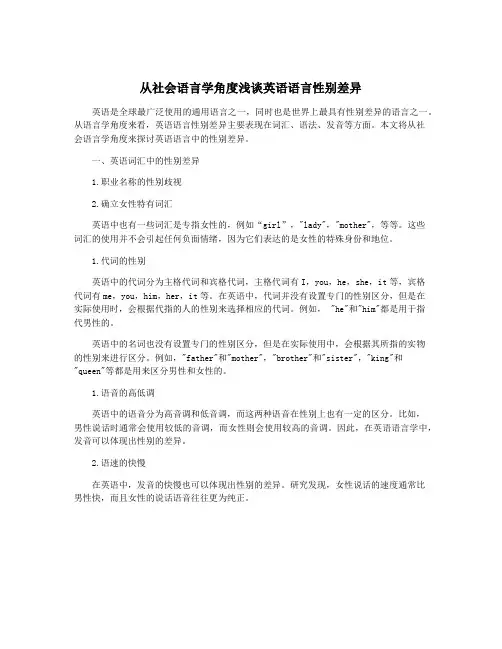
从社会语言学角度浅谈英语语言性别差异英语是全球最广泛使用的通用语言之一,同时也是世界上最具有性别差异的语言之一。
从语言学角度来看,英语语言性别差异主要表现在词汇、语法、发音等方面。
本文将从社会语言学角度来探讨英语语言中的性别差异。
一、英语词汇中的性别差异1.职业名称的性别歧视2.确立女性特有词汇英语中也有一些词汇是专指女性的,例如“girl”,"lady","mother",等等。
这些词汇的使用并不会引起任何负面情绪,因为它们表达的是女性的特殊身份和地位。
1.代词的性别英语中的代词分为主格代词和宾格代词,主格代词有I,you,he,she,it等,宾格代词有me,you,him,her,it等。
在英语中,代词并没有设置专门的性别区分,但是在实际使用时,会根据代指的人的性别来选择相应的代词。
例如, "he"和"him"都是用于指代男性的。
英语中的名词也没有设置专门的性别区分,但是在实际使用中,会根据其所指的实物的性别来进行区分。
例如,"father"和"mother","brother"和"sister","king"和"queen"等都是用来区分男性和女性的。
1.语音的高低调英语中的语音分为高音调和低音调,而这两种语音在性别上也有一定的区分。
比如,男性说话时通常会使用较低的音调,而女性则会使用较高的音调。
因此,在英语语言学中,发音可以体现出性别的差异。
2.语速的快慢在英语中,发音的快慢也可以体现出性别的差异。
研究发现,女性说话的速度通常比男性快,而且女性的说话语音往往更为纯正。
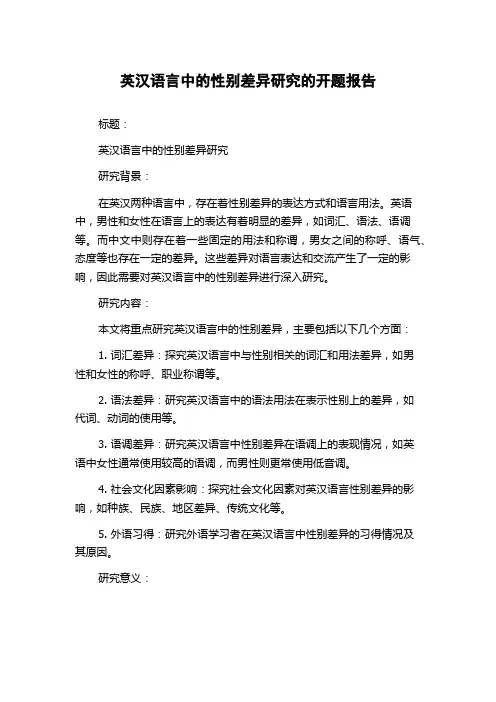
英汉语言中的性别差异研究的开题报告标题:英汉语言中的性别差异研究研究背景:在英汉两种语言中,存在着性别差异的表达方式和语言用法。
英语中,男性和女性在语言上的表达有着明显的差异,如词汇、语法、语调等。
而中文中则存在着一些固定的用法和称谓,男女之间的称呼、语气、态度等也存在一定的差异。
这些差异对语言表达和交流产生了一定的影响,因此需要对英汉语言中的性别差异进行深入研究。
研究内容:本文将重点研究英汉语言中的性别差异,主要包括以下几个方面:1. 词汇差异:探究英汉语言中与性别相关的词汇和用法差异,如男性和女性的称呼、职业称谓等。
2. 语法差异:研究英汉语言中的语法用法在表示性别上的差异,如代词、动词的使用等。
3. 语调差异:研究英汉语言中性别差异在语调上的表现情况,如英语中女性通常使用较高的语调,而男性则更常使用低音调。
4. 社会文化因素影响:探究社会文化因素对英汉语言性别差异的影响,如种族、民族、地区差异、传统文化等。
5. 外语习得:研究外语学习者在英汉语言中性别差异的习得情况及其原因。
研究意义:本文研究英汉语言中的性别差异及其影响,对于语言教育、跨文化交际、社会文化研究以及性别研究等领域都有一定的意义与价值。
具体有以下几个方面:1. 为语言教育者提供合理性别教育及性别意识教育内容、方法、途径等方面的指导2. 对外交往、跨文化交流中的语言交际问题提供参考和借鉴3. 推进性别研究领域的发展与进步4. 拓宽语言学研究的广度,增强语言研究的深度研究方法:本文采用文献资料法和调查法进行研究。
文献资料法将从文献、书籍、期刊、研究报告等方面收集和整理有关英汉语言中性别差异的资料,进行归纳、总结和分析。
调查法将对英汉语言中性别使用情况进行问卷调查,对调查数据进行整理并分析,从而达到探究性别差异在实践中的体现和认识。
预期成果:本文预计达到以下成果:1. 了解英汉两种语言中存在的性别差异的情况2. 总结归纳英汉语言中性别差异的表达方式和语言用法3. 探究社会文化因素对性别差异的影响4. 了解男性和女性在英汉语言中语调使用的不同5. 为语言教育者提供合理性别教育和性别意识教育的指导参考文献:1. Gal, S. (1978). Peformative acts and gender constitution: An essay in phenomenology and feminist theory. Theatre Journal, 30(4), 519- 531.2. Goffman, E. (1974). Gender Advertisements. Studies in the Anthropology of Visual Communication, 1(2), 69-153.3. Lakoff, R. (1975). Language and woman's place. Language in Society, 2(1), 45-81.4. Li, X., and Tanaka, S. (2010). Gender differences in language use among students in a Chinese university. Chinese Language and Discourse, 1(2), 128-146.5. Zhang, Q. (2010). Gender differences in spoken discourse of English and Chinese. International Journal of English Linguistics, 1(2), 60-65.。
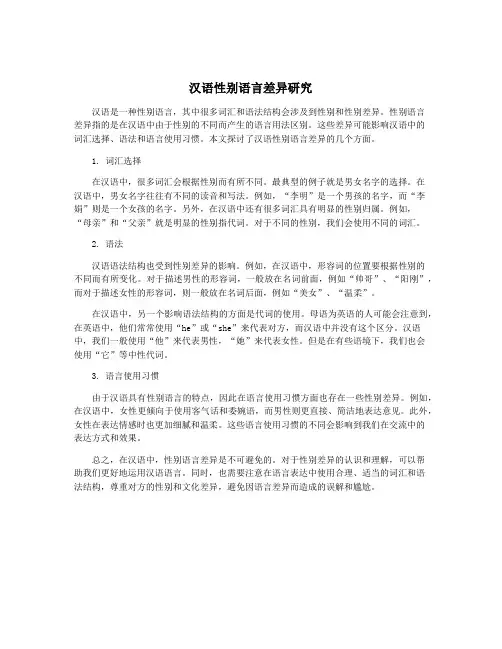
汉语性别语言差异研究汉语是一种性别语言,其中很多词汇和语法结构会涉及到性别和性别差异。
性别语言差异指的是在汉语中由于性别的不同而产生的语言用法区别。
这些差异可能影响汉语中的词汇选择、语法和语言使用习惯。
本文探讨了汉语性别语言差异的几个方面。
1. 词汇选择在汉语中,很多词汇会根据性别而有所不同。
最典型的例子就是男女名字的选择。
在汉语中,男女名字往往有不同的读音和写法。
例如,“李明”是一个男孩的名字,而“李娟”则是一个女孩的名字。
另外,在汉语中还有很多词汇具有明显的性别归属。
例如,“母亲”和“父亲”就是明显的性别指代词。
对于不同的性别,我们会使用不同的词汇。
2. 语法汉语语法结构也受到性别差异的影响。
例如,在汉语中,形容词的位置要根据性别的不同而有所变化。
对于描述男性的形容词,一般放在名词前面,例如“帅哥”、“阳刚”,而对于描述女性的形容词,则一般放在名词后面,例如“美女”、“温柔”。
在汉语中,另一个影响语法结构的方面是代词的使用。
母语为英语的人可能会注意到,在英语中,他们常常使用“he”或“she”来代表对方,而汉语中并没有这个区分。
汉语中,我们一般使用“他”来代表男性,“她”来代表女性。
但是在有些语境下,我们也会使用“它”等中性代词。
3. 语言使用习惯由于汉语具有性别语言的特点,因此在语言使用习惯方面也存在一些性别差异。
例如,在汉语中,女性更倾向于使用客气话和委婉语,而男性则更直接、简洁地表达意见。
此外,女性在表达情感时也更加细腻和温柔。
这些语言使用习惯的不同会影响到我们在交流中的表达方式和效果。
总之,在汉语中,性别语言差异是不可避免的。
对于性别差异的认识和理解,可以帮助我们更好地运用汉语语言。
同时,也需要注意在语言表达中使用合理、适当的词汇和语法结构,尊重对方的性别和文化差异,避免因语言差异而造成的误解和尴尬。
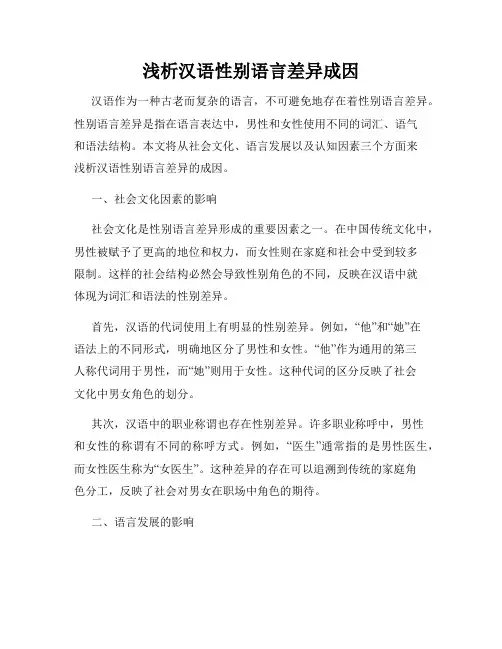
浅析汉语性别语言差异成因汉语作为一种古老而复杂的语言,不可避免地存在着性别语言差异。
性别语言差异是指在语言表达中,男性和女性使用不同的词汇、语气和语法结构。
本文将从社会文化、语言发展以及认知因素三个方面来浅析汉语性别语言差异的成因。
一、社会文化因素的影响社会文化是性别语言差异形成的重要因素之一。
在中国传统文化中,男性被赋予了更高的地位和权力,而女性则在家庭和社会中受到较多限制。
这样的社会结构必然会导致性别角色的不同,反映在汉语中就体现为词汇和语法的性别差异。
首先,汉语的代词使用上有明显的性别差异。
例如,“他”和“她”在语法上的不同形式,明确地区分了男性和女性。
“他”作为通用的第三人称代词用于男性,而“她”则用于女性。
这种代词的区分反映了社会文化中男女角色的划分。
其次,汉语中的职业称谓也存在性别差异。
许多职业称呼中,男性和女性的称谓有不同的称呼方式。
例如,“医生”通常指的是男性医生,而女性医生称为“女医生”。
这种差异的存在可以追溯到传统的家庭角色分工,反映了社会对男女在职场中角色的期待。
二、语言发展的影响语言发展也是造成汉语性别语言差异的原因之一。
汉语经历了漫长的发展过程,形成了丰富多样的语言表达方式。
在这个过程中,汉语逐渐形成了一些用于区分性别的词汇和语法结构。
首先,汉语中的“女字旁”和“男字旁”是反映性别差异的一个例子。
例如,“她”和“它”中的“女”字旁明确地表明了该词语与女性有关,“他”中的“男”字旁则表示与男性有关。
这些字旁的使用在一定程度上反映了语言发展中对性别的意识和区分。
其次,汉语中存在针对男性和女性的敬称差异。
对于长辈或者地位高的人,男性常称为“大哥”、“叔叔”等词汇,“小姐”、“阿姨”等则用于女性。
这种语言差异与汉语中的谦让文化有关,反映了对性别和地位的尊重。
三、认知因素的作用除了社会文化和语言发展,个体的认知因素也会对汉语性别语言差异产生影响。
个体在语言学习和使用过程中会被社会环境、经验和认知方式所塑造,从而对性别在语言中的表达方式产生差异。
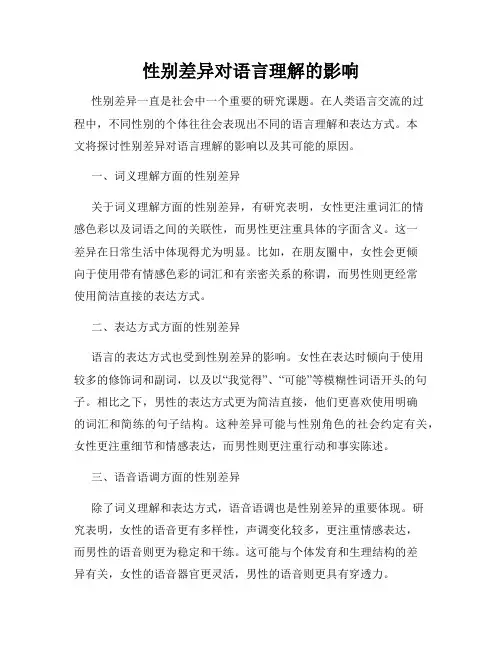
性别差异对语言理解的影响性别差异一直是社会中一个重要的研究课题。
在人类语言交流的过程中,不同性别的个体往往会表现出不同的语言理解和表达方式。
本文将探讨性别差异对语言理解的影响以及其可能的原因。
一、词义理解方面的性别差异关于词义理解方面的性别差异,有研究表明,女性更注重词汇的情感色彩以及词语之间的关联性,而男性更注重具体的字面含义。
这一差异在日常生活中体现得尤为明显。
比如,在朋友圈中,女性会更倾向于使用带有情感色彩的词汇和有亲密关系的称谓,而男性则更经常使用简洁直接的表达方式。
二、表达方式方面的性别差异语言的表达方式也受到性别差异的影响。
女性在表达时倾向于使用较多的修饰词和副词,以及以“我觉得”、“可能”等模糊性词语开头的句子。
相比之下,男性的表达方式更为简洁直接,他们更喜欢使用明确的词汇和简练的句子结构。
这种差异可能与性别角色的社会约定有关,女性更注重细节和情感表达,而男性则更注重行动和事实陈述。
三、语音语调方面的性别差异除了词义理解和表达方式,语音语调也是性别差异的重要体现。
研究表明,女性的语音更有多样性,声调变化较多,更注重情感表达,而男性的语音则更为稳定和干练。
这可能与个体发育和生理结构的差异有关,女性的语音器官更灵活,男性的语音则更具有穿透力。
四、影响因素及局限性性别差异对语言理解的影响可能受到多种因素的共同作用。
社会文化因素、生理结构以及心理特征等都可能对性别差异产生影响。
然而,这种性别差异并非绝对存在,个体差异也非常明显。
同样是女性,不同个体之间的语言理解和表达方式也会有所不同。
因此,在研究性别差异对语言理解的影响时,需要考虑到个体差异以及其他潜在因素的影响。
总结:性别差异对语言理解的影响有词义理解方面的差异、表达方式方面的差异以及语音语调方面的差异。
这些差异可能与社会文化、生理结构和个体心理特征等因素相关。
然而,性别差异并不是绝对存在的,个体差异也需要被重视。
因此,在日常交流中,我们应该更加注重个体的差异,尊重他人的表达方式,避免过度概括和论断。
性别社会语言学视角下的教师语言研究性别语言差异是社会语言学的重要研究领域。
文章从教师语言的性别差异出发,探讨了男女教师在课堂教学语言使用中存在的差异及其成因,并提出了建议。
标签:性别;社会学;教师语言一、社会学视角下的教师语言性别差异研究1.性别语言研究孙汝建写过《性别与语言》初涉性别语言问题,后来将之发展为《汉语性别语言学》,具体研究了汉语中的性别歧视和性别差异,分析了它们的成因。
赵蓉辉的《语言与性别》则着重对口语进行了社会语言学的研究。
艾晓明翻译了玛丽·塔尔博特的《语言与社会性别导论》,将国外对这一话题的讨论结果介绍到国内。
杨春《性别语言研究》一书,界定语言和性别问题为社会语言学的经典问题。
2.教师语言研究性别与教师语言的研究有张静的《教师语言性别差异之初探》,关注教师的“课堂语言”。
侯佐恂《不同性别大学英语教师指令性言语行为语用研究》将语言具体到大学英语课堂指令性言语,研究的操作性大大提高。
二、社会性别视角下的教师语言1.语音语调课堂教学中,口头表达是教师语言中最重要的部分,男女教师在语音方面的差异不容忽视。
从音高来讲,女性声带较短较薄,音高较高,男性相反。
除了先天生理因素外,女性对发音正确性敏感度高于男性,她们更重视自己语音的标准性,而男性发音则在标准基础上口腔肌肉相对松弛。
男女教师在课堂上的语音面貌同样具备上述特点。
2.词汇选择研究表明,男女言语中存在词汇选择的差异。
口语中,男性更多使用强感叹词,女性相反。
在语气词的使用上,男性更多使用具有决断意义的词汇,女性则更倾向于使用模糊语以弱化语气。
与女性相比,男性更多使用俚语,男性普遍认为俚语更能体现男子气概。
课堂教学上,这种词汇选择差别在课堂管理行为中差异明显。
男教师课堂管理语言直接果断,女教师的语言则委婉客气。
3.话语风格第一,在话题选择方面存在差异。
女性对情感、影视、购物及家庭成员谈论较多,男性则较多讨论政治、军事、科技以及两性玩笑等话题。
儿童语言发展的性别差异与影响因素儿童语言发展是指孩子在成长过程中逐渐掌握和使用语言的能力。
语言的发展过程受到多种因素的影响,其中性别差异是一个值得关注的方面。
本文将探讨儿童语言发展中存在的性别差异以及对这些差异的影响因素。
一、性别差异的存在从早期婴儿期开始,男孩和女孩在语言发展上就存在一些差异。
研究发现,女婴比男婴更早开始语言表达,使用的词汇也更多。
在幼儿期,女孩通常能更快掌握语音和词汇,表达的内容也更加丰富。
而男孩则在语言的发音和词汇使用上相对较慢。
二、生物学因素的影响性别差异的存在可能与生物学因素有关。
研究表明,不同性别的婴儿在语言区域的脑活动上存在差异。
女性大脑更注重语言处理,而男性大脑在空间认知方面更为突出。
这可能解释了为什么女孩在早期语言发展上更快一些。
三、社会环境的影响除了生物学因素,社会环境也对儿童语言发展产生重要影响。
家庭、学校和社会文化等因素都可能对儿童的语言发展产生积极或消极的影响。
研究发现,女孩在家庭环境中通常会得到更多的语言刺激和亲密交流,这可能有助于她们更快地掌握语言能力。
四、语言环境的影响除了社会环境,孩子所处的语言环境也会对他们的语言发展产生影响。
孩子在学龄前接触到的语言环境,如家庭和托儿所的语言环境,可能对他们的语言表达和沟通能力产生深远影响。
不同的语言环境可能对男孩和女孩的语言发展产生不同的影响。
五、教育方式的影响在学校教育中,教育方式也会影响到儿童的语言发展。
研究发现,女孩通常受到更多的语言刺激和鼓励,这可能有助于她们更好地发展语言能力。
而对于男孩来说,可能需要更多的关注和支持来提升他们的语言表达能力。
六、性别偏见的影响社会文化中存在的性别偏见也可能对儿童的语言发展产生一定的影响。
常见的性别偏见包括认为女孩在语言能力上更优秀,男孩在数学和科学方面更出色。
这种偏见可能导致教育者和家长对儿童语言发展的期望存在差异,进而影响到孩子的发展。
七、提升性别平等和语言发展的措施为实现性别平等和促进儿童语言发展,应采取一系列措施。
最近三十年来的语言性别差异研究摘要有关性别差异的研究是一个跨学科的研究课题,它是社会学、心理学、语言学、女权主义等领域的研究对象之一。
本文从社会语言学的视角对有关性别差异研究的文献进行了分析和归纳,旨在通过文献综述,对语言中的性别差异研究进行历时性的回顾,并在此基础上总结该领域研究的成就与不足。
关键词:社会语言学最近三十年性别差异文献综述中图分类号:h0-0 文献标识码:a一引言有关性别差异的研究是一个跨学科的研究课题,它是社会学、心理学、语言学、民族学、女权主义等领域的研究对象之一。
这些研究领域从不同的学科角度、不同的研究方法出发,探讨了男性和女性之间在社会生活中表现出来的种种差异。
性别差异在语言中的表现是一个复杂的问题,因为它既是一种语言现象,也是一种社会现象。
于是出现了很多与此相关的术语:“女性语言”(women’s language)、“女性语域”(the female register)、“性别语言”(genderlect)和“与性别相关的语言”(gender-related language)等等。
otto jespersen(1922)的著作拉开了英语性别差异研究的序幕,但继他之后的研究却大多采用了传统的语言学研究方法模式。
直到20世纪60年代以来,社会语言学作为一门新兴的独立学科得到了迅速的发展,学术界才更多地采取社会语言学的研究方法对语言的性别差异进行了研究。
正如杨永林所说:“语言性别差异研究,作为社会语言学有别于其他语言学研究的显着标志之一,在70年代风靡西方世界的女权运动的激励和影响之下,如高屋建瓴之势,一发而不可收。
”社会语言学借鉴和吸收了社会学的一些调查研究方法,对英语里的语言变体进行了科学而又详尽的分析,通过准确的数据资料直观地反映出英语性别差异的方方面面。
因此,从社会语言学视角对语言中的性别差异进行分析的文章越来越多。
二学术专著与论文综述在学术专著方面,陈原的《语言与社会生活:社会语言学札记》(1980)是国内第一步社会语言学专著。
性别差异对孩子语言发展的影响引言语言是人类交流和表达思想的重要工具之一,而性别差异在语言发展中扮演着重要的角色。
许多研究发现,男孩和女孩在语言能力上存在一些差异,这可以从两性在大脑结构、生理功能和社会环境等方面的不同来解释。
本文旨在探讨性别差异如何影响孩子的语言发展,并介绍相关研究和观点。
性别差异与大脑结构大脑结构是性别差异对语言发展影响的重要因素之一。
神经科学研究表明,男性和女性大脑在形态、功能和连接方式上存在着一些差异。
例如,男性大脑相对于女性更加侧重于运动和空间感知,而女性更擅长情绪处理和社交能力。
这些差异可能会影响儿童习得语言的方式,并导致男孩和女孩之间在某些语言技能上表现出不同。
生理因素对语言发展的影响除了大脑结构外,生理因素也可能对性别差异在语言发展中的影响起到一定的作用。
研究表明,荷尔蒙水平和基因因素与性别差异以及语言能力之间有一定的关联。
例如,男孩在青春期前后会产生更多的睾酮荷尔蒙,这可能会影响他们的语言发展速度和方式。
此外,某些基因变异也被认为与语言障碍和性别差异有关。
社会环境与性别角色塑造社会环境在培养孩子语言能力方面起到重要作用,并且也与性别差异密切相关。
从小儿园到学校再到家庭,儿童接触到的社会化环境中存在着不同的性别角色塑造。
研究发现,女孩通常更加倾向于合作和表达情感,而男孩则更注重竞争和物理动作。
这些社会角色期望可能会对儿童语言发展产生影响,并进一步增加了性别差异。
性别差异与语言技能发展考虑到上述因素,我们可以看到男孩和女孩之间在不同语言技能上存在一些差异。
例如,女孩往往在语法和词汇方面表现更好,而男孩则更擅长于空间导航和解决问题。
此外,研究还发现男性和女性可能有不同的语言学习策略和风格,这也进一步影响了他们的语言发展。
总结因为大脑结构、生理因素和社会环境的差异,性别对儿童语言发展产生了一定的影响。
男孩和女孩在语言技能上存在一些差异,这可以从大脑功能、生理水平以及社会角色塑造等方面得到解释。
66语言性别差异及跨性别交际研究赵海成 刘心童华北理工大学摘要:语言性别差异普遍存在,跨文化交际中不可避免涉及两性差异问题。
本文试从性别及性别差异界定开始,分析性别差异产生原因,及其在言语交际和非言语交际两个层次的具体差异表现,从理论到实践,为减少两性交际过程中的摩擦与误会、促进两性和谐相处提供借鉴。
关键词:性别差异;跨性别交际;影响因素;应对策略一、引言近年来,随着社会语言学和跨文化交际学的发展,越开越多学者将研究方向转入某一主流文化中亚文化分支的探索。
性别文化作为重要的亚文化范畴,将社会语言学性别差异理论框架与跨文化交际实践相结合,新的研究领域—跨性别交际,成为了关注焦点。
语言学界关于性别的研究最早可以追溯到17世纪。
1992年,丹麦语言学家叶斯帕森在其颇有影响力的著作《语言:本质、发展及起源》(Language:Its Nature,Development and Origin)中,专门利用一章篇幅介绍女性语言表现及特点,阐述女性在词汇和句法等方面的差异。
这是最早从语言学视角开展的对语言和性别差异的研究。
由于不同性别之间,对彼此性别文化所导致的呈现表征缺乏了解,跨文化交际问题随之产生。
跨性别交际存在极大研究价值,是每个人日常生活不可回避的现实问题。
二、性别及性别差异(一)性别及性别差异对于“性别”一词,英语中有两个对应词:sex和gender。
一般交际中,“sex”和“gender”经常混用。
但实际界定上“sex”和“gender”存在明显区别。
“sex”指男女两性之间的生理差异,是静态的,不能改变的。
而“gender”更侧重男女两性之间社会、文化、心理等方面的差异,是动态的,是可以在有限生命里构建、重塑、改变的。
本文主要从“gender”视角分析跨性别交际中的性别差异。
(二)影响性别差异产生的原因1.生理因素根据解剖学理论,女性大脑左侧半球语言中枢发育较男性发达,且发育较早,为语言机能发展提供了良好的生理基础,使女性在语言能力上具有一定优势。
Language Gender DifferencesTable of Contents Abstract (I)Introduction (1)1 Domestic and International Background of the Research in Language andGender (1)2. Aim and Function of this Research (1)Chapter One Gender Differences in Language (2)1.1 The aspects of pronunciation and Intonation (2)1.2Lexical Items Aspects (3)1.2.1Females grasp color words better than males (3)1.2.2Females prefer to use emotional words than males (3)1.2.2.1 The use of adjectives (4)1.2.2.2 The use of adverbs (4)1.2.2.3 Intimate words (4)1.3 Syntactic Aspects (4)1.4 Speech style (5)1.5 Daily Conversation (5)1.5.1 Differences in Topic Selection (5)1.5.2Difference in the Choice of Words (6)1.5.3Difference in Conversation Quantity (6)1.5.4Difference in cooperation (6)Chapter Two Possible Causes of Language Differences in Gender (7)2.1Culture Factors (7)2.2Society Factors (8)2.2.1Social Status (8)2.2.2 Definition of Gender Role (8)2.3Physiology Factor (9)2.4Psychological Factor (9)2.5 Personal Experiences (9)Conclusion (10)Bibliography (11)AbstractGender difference is a popular research topic for many disciplines, and linguistics is no exception. The study of gender differences in language sociolinguistics has been the focus of on of the issues. Since the nineties of last century onwards until the early twenty-first century, due to the impact of the wave of globalization, the development studies of language and gender have stepped into a very active period, showing a diverse, dynamic, and localized trend.Our paper focuses on the differences in language and gender and we attempt to penetrate the causes of these differences. We analyze differences from the aspects of phonetics, lexical level, syntactic level, speech style and conversation. By comparing their differences, we want to probe the reasons that lead to such phenomenon .In the end of our paper, we also want to point out the trend of the language changes in gender.Key words: English linguistic, gender differences, causesIntroduction1 Domestic and International Background of the Research in Language and GenderThe study of this topic began in the late seventies of and the early eighties, later to the West. The initial research results are mostly in English translation and introduce the gender discrimination and gender differences. Since the eighties, our researchers were relatively independent of academic language in the form of gender issues surrounding the study and presented some of the research topic. Overall view, the research of language and gender covers the following aspects: from the differences the appearance of voice tone, word choice, syntax choice, choice of different language to the deep-seated gender discrimination, social gender differences and the relationship between language use , gender differences in verbal communication, gender impact of the use of language and so on. These studies open up a new field of language study, has a very important practical significance on social development and human progress. Issues of language and gender are popular between linguistic and sociolinguistic study as an important component of language vocabulary system. Appellations also have gender differences. However, among our language scholars, the title of Gender Studies is basically a piece of virgin land not cultivated. Appellation and the genders have a very close relationship, the two are inseparable. Change of address forms to reflect the social culture, impacts on men and women and different social expectations, and the semantics of Appellations can reflect the social and cultural awareness of gender bias attitudes. At the same time, gender restricts the production and development of appellations. Thus, the study of gender differences has much room for development.2. Aim and Function of this ResearchThis paper aims to exam gender differences in language performance, explore new areas of gender studies language, enrich the content of the study, find the methods of exploration, gender usage, and explore its hidden reasons for the social and cultural history. Theoretically, it helps us to deepen the understanding of the universal law of language system, to broaden our research horizons; help explain language development and changes, and find out external factors impact on the structure of language itself. From a practical sense, it can help people become more aware of the similarities and differences between men and women in the use of language and has practical significance communication and understanding. From a social sense, the study of gender differences in language can regulate some of the disputed phenomenon of social communication, play a correct orientation effect on the social construction and play an active role on spiritual and material civilizationChapter One Gender Differences in Language Jespersen is the earliest linguists that note the difference of linguistic gender. According to her observation, American women like using hedge, booster, and expletive. On the use of syntactic, they often use addition questions and excessively polite and correct form. In pronunciation, they often use the rising tone after the declarative sentence. So, next, I will introduce you their differences. Differences are as below:1.1 The aspects of pronunciation and IntonationWomen generally keep highly sensitivity in the correctness of pronunciation and intonation. They are more inclined to use the pronunciation way which is standard, authoritative. Generally speaking, women speak with the rising tone, changing tone and expressive. But when men speak,they always use the falling tone and the tone changes little. Secondly, the female's intonation pattern is hesitant, feeble, high tones and expressive. And men's intonation pattern is smooth and firm. And their expression is insufficient, sometimes almost monotonous. For example, when we ask the question that “When will the dinner be ready?”Women will use the rising tone of interrogative sentences to answer that “Oh, around six o‟clock.” Instead, men will use positive tone of falling replied: "Seven o 'clock.".1.2Lexical Items Aspects1.2.1Females grasp color words better than malesGenerally speaking, females are more sensitive about color words. They are good at using color words borrowed from grammar, such as light purple, amaranth, and taupe, which sounds elegant. Thus females are believed to use elegant color words, however, males do not resort to these words, in fact, and they have no interest in color words. The reason for this phenomenon is that women usually talk about colorful clothes. From aesthetic perspective, the external beauty they feel is more profound than males.1.2.2Females prefer to use emotional words than malesFemales like to use emotional words in language activities, such as praise words, polite words and emphasize words. According to a research, women use emotional words frequently just twice as much as men. They are good at using language expression means and portrayed means, whose purposes are not to flatter the other person, but to make the conversation come to the point, which can contribute to a pleasant conversation. In spoken English, we can notice that women use more adjectives, adverbs and intimate words to show emotions than men.1.2.2.1 The use of adjectivesWomen are found to overuse some exaggerated adjectives. Although these words are also used by men, yet the occasion and meaning are different.1.2.2.2 The use of adverbsFemales use adverbs of degree more frequently than males to emphasize. They often use such adverbs to express trivia, while males are apt to use toner weaker words when they want to emphasize. Maybe this has something to do with male‟s characteristics.1.2.2.3 Intimate wordsWomen are supposed to be gentle, kind and virtuous. V ery likely, they use high-level intimate words in language to show adoration, care and love to the listener. From this, we can conclude that emotional words become communicative lubricants; they also show that women‟s emotion is easy to perform. Females are better good at using euphemistic terms than males, there is no doubt that women are careful in choosing words appearance, figure and age. This is mainly because that if women often use rude words, they will be supposed to be uneducated and vulgar. While in daily life, men usually use strong expletives, such as shit, hell, damn and so on.1.3 Syntactic AspectsIn the grammatical structure, gender language mainly divided into three aspects.Firstly, women most use mudra structure. Namely, the modal verb can, could, shall, should, will, would, may and might use with other auxiliary verbs. This reflects women‟s uncertain thethings what are happening around them. Usually men will use a few positive, authoritative andimperative words.Secondly, women tend to use women tend to use. In contrast, men use more statements and omission WH -questions. For example, "this program is very exciting, isn't it?" Men's tendency to seldom use tag questions shows their confidence of using language and strength. The tendency of women more use tag questions shows their uncertainty to language.Thirdly, men tend to use the imperative. They generally uses simple and directly order form.Such as: Pass me a cup of tea! But women usually use direct circuitous structure. For example:Would you pass me a cup of tea?1.4 Speech styleIn traditional society,men dominate the dominant position, while women are subordinate status. This is what makes them differ in topic control, conversation conversion, diction color, etc.Men are prone to be manipulative, and always hope to utilize his likes and dislikes to control conversation. Language experts put this difference in the verbal communication style into two categories: “powerful style” and “powerless style”.1.5 Daily Conversation1.5.1 Differences in Topic SelectionIn daily conversation, we usually find that men and women hoose their topics from different aspects. Generally, women tend to talk about personal, or things connected with current issues. However, males are apt to talk about the opposite topics. They seldom confide secrets to others directly and often keep acertain distance with current surroundings. In addition, they also choose words they use differently.1.5.2Difference in the Choice of WordsIn male and female discourse, differences in diction can be found. There are great gender differences in the choice of words. For example, women are found to use more qualifiers and intensifiers such as so, really, very and absolutely. Women are more often use polite expression, including please, thank you, you are so kind, as well as embedded imperative, e.g. Will you please close the door? They seldom use dirt and coarse language, and they usually use beautiful and delicate words this is all because women have no power in society and they use such kind of language to show that they are unsure about what they say.1.5.3Difference in Conversation QuantityAs to conversation quantity, people hold a fairly common and stereotyped perspective that women talk more than men. However, it is not the case. For example, someone once constantly observed a couple for 3 hours in a social party. He found that in this period the husband‟s talking is five times as many as his wife. But afterwards, when asking the other people to present impression to the couple, unexpectedly everyone said that the husband didn‟t say much while the wife was talkative.So far, almost all of the investigation and study have reached a conclusion that was opposite to people‟s fixed idea: namely male discourse quantity is more than women.1.5.4Difference in cooperationGenerally, women are comparatively more cooperative in the conversation performance. They usually take turns. But in comparison, men show their strong competition in the conversation. They tend to control the choice of topic and the opportunity to discourse, and would not easily concede speech right. In the conversation, men convert and jump their topic frequently without consistency. They are not aware of listener‟s reaction and participation. Of course, when someone is talking, they reflect slowly, probablyfudged. And they seldom agree with what others said. During the conversation, men often interrupt others with direct and stiff tone. Hence, conversation between males is often with trace of loud voice, conflict and assault. Quarrel, roar, curses, threat, and mocking are more notable than women.It‟s easy to find that heterosexual conversation is basically under the control of men. One of the reasons is that women are more cooperative, implicative, and ready to listen to others‟opinions with active reaction. Nevertheless, men are more prone to seize opportunities, and often interrupt others. Thus causes women‟s silent reaction.Chapter Two Possible Causes of Language Differences in GenderFrom the differences in linguistic and gender mentioned above, it is easy for us to find the gender differences in English language. Then it comes to reveal the possible cause of this kind of differences. Because language is closed related to society, psychology, culture, individual features and so on, we try to analyze from 5 aspects. They are culture, society, psychology, physiology, and individual experience.2.1Culture FactorsLanguage is the carrier of culture, which at the same time, restricts the language. Women‟s speech just reflects the cultural expectations which call for niceness, politeness and ladylike expression, which is educated diction, avoiding bad words. At the same time, sexual terms are more acceptable to be used by men, who will be regarded as “one of the guys”. A culture usually divides behaviors into masculine and feminine. In our culture we are likely to regard the men who show the behaviors, styles, or interests that are usually attached to women as “womanish” and to call the boys who behave in this way “sissies.” Women who have interests that usually belong tomen are referred to as “manish” and the girls who behave in this way are often called “tomboys.” As a result, even a little boy, knows the way in which he should behave himself, for he is afraid of being referred to as “sissy”. In one word, no matter a man or a woman has to pay attention to his or her speech and behavior because there is a division given out by their culture, which is deep-rooted in their mind.2.2Society Factors2.2.1Social StatusThere is no denying that it is a society which men are superior to women. Men hold absolute dominance, while women are put into secondary status. This reason can best explain why women are indirect in proposing their request even orders.2.2.2 Definition of Gender RoleWith regard to gender roles, they are referr ed to as the …social definition‟ of women and men. No matter in which society and culture, it seems that the definition of gender role is similar. Women are responsible for the domestic affaires and men try to make money to support his family. As a result, men and women are different from each other in topic selection in conversation. It is the Social values that confine female speakers to certain topics such as child-bearing, personal relationships. Besides, as a mean of communication, language, for most women, is mainly helpful to establish harmonious interpersonal relationship. For most men it is a means to preserve authority and maintain status in a competitive society. What‟s more, according to past sociolinguistic studies, harmony-seeking can be considered as of inferior social status among men. Therefore, the reason for their different communication styles is that in fact the purposes they use language in conversation are not the same.2.3Physiology FactorThere is a famous saying that men are from Mars and women are from Venus. Certainly we can not therefore attribute the difference between women and men to this saying. Thanks to modern science which has provided some credible evidence. It has been widely known that language ability is controlled by the left part of the brain. However, researchers from Georgetown University headed by Michael Ullman recently claim that boys and girls tend to use different parts of their brain to learn some fundamental parts of grammar and certain diction learning. This study may explain the difference between men and women in diction the correctness of grammar.2.4Psychological FactorIn most English speaking communities, it has been discovered that women are more careful than men. And they are quiet, gentle, emotional and always look forward to male‟s protection and a sense of security. While men are brave, impulsive, adventurous and sometimes careless. Accordingly, women tend to use more standard or educated expressions in their speeches. Besides it has been suggested that men tend to think logically, while women are likely to think emotionally. This point may best testify that when in face of unlucky events or complains, men will try to come up with a solution while women try to show their sympathy.2.5 Personal ExperiencesDefinitely, the gender difference is related to one‟s own growing experiences. A boy, when he is asked to be the leader from a very early age, will use more ordered patterns in his language. On the contrary, a boy , who grow up with women surrounded and without men taught, may be will be the so-called “sissies.” And he will be less confident and powerful.ConclusionBy and large, gender difference, as a social phenomenon, has been reflected in language and been studied in many separate areas for a long time. In the past decades, sociolinguistic research dealing with relationship between gender difference and language has undergone significant change and gain full development. This paper surveys the results from the current and previous researches, and our ideas and comprehension are added as well. We attempt to find analyze the differences and penetrate into the causes of these differences.We can see that with time passing by, there are less and less differences in language and gender. However, there is no denying that the differences will exist permanently.It should be pointed out that the way is still endless for researchers to disclose more and more detailed difference between male and female speakers as well as their specific causes, which is of great values in the field of English teaching and learning as well as cross-cultural exchanges.Near the end, what we want to emphases is that with the limitation of our knowledge, the resources that we can get, the time left for us and so forth, mistakes is inevitable. And we appreciate your advices and guides.Bibliography[1]Thorne. B.et al. Language, Gender, Society. [M] .New York: Newbury House, 1983.[2]Zhu Manzhu. Psychological Linguistic. [M ].Shanghai. East China Normal University Press,1990[3] Zhao Ronghui. Language and Gender. [M].Shanghai: Shanghai Foreign Language Education Press, 2003.[4]Jespersen, O.1922. Language: Its Nature,Development,and Origin.[M].London: Allen and Unwin.。